|
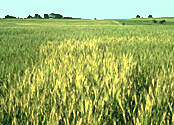
Click on the image for an
enlargement and more information. |
Abstract
During the 7 - 11 August Joint American and Canadian Phytopathological Society meeting in Montreal, Canada, the American Phytopathological Society (APS) hosted a symposium entitled "Plant Pathology’s Role in Anti-Crop Bioterrorism and Food Security." Because of the interest in this topic, we are providing this APSnet feature article and discussion session as a platform for interested APS members and others to further discuss and develop ideas to help increase our nation’s crop biosecurity and food safety. Over the past several years there has been an increase in new and emerging plant diseases. Although these diseases are a likely result of natural causes, instances of deliberate introduction cannot be ruled out. We present references to several books, articles, and web sites which refer to anti-crop bioterrorism and biowarfare.
Introduction
Agriculture, especially related to crops, is an extremely important component of the U.S. economy. Crop production can be negatively influenced to a great degree by numerous factors including crop management, severe weather conditions, diseases, and pests. Concomitantly, prices of resulting food products and export commodities can be negatively impacted. In addition to natural outbreaks of plant diseases, growers could very well be faced with deliberate releases of pathogens or pests by individuals, nation-state terrorists, extortionists, those wishing to influence trading markets or exports, and others.
|
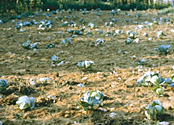
Click on the image for an
enlargement and more information. |
The recent APS symposium on anti-crop bioterrorism chaired by Dr. Anne Vidaver and sponsored by the Office of International Programs, Regulatory Plant Pathology, and Bacteriology committees was intended to better educate plant pathologists and the public about the potential of crop bioterrorism. In his keynote address, Dr. Tom Frazier stressed the need for government to address crop bioterrorism issues and for plant pathologists to assist in developing a science-based defense plan for crops (Dr. T. W. Frazier, "Bioterrorism and agriculture,"
see abstract). Several newspaper articles have been written about the APS symposium including: 1)
Columbus Dispatch; and 2)
Calgary Herald. The
Calgary Herald article entitled "Crop Warfare Combat Plan Urged" by Grant Robertson, provides a broad overview of the symposium.
Because of the great importance and interest in the topic, this feature article has been prepared to provide a platform for interested members and others to further discuss and develop ideas for dealing with crop biosecurity issues. Numerous representatives of the administration and congress have publicly registered great concern regarding the threat of biological warfare (BW) to this country, especially manifested as bioterrorism. In comments that were widely circulated in the press, Secretary of Defense William Cohen warned Americans of the likelihood of biological weapons attacks in the coming months and years. One of the most important points made by the Secretary is that being prepared for an attack which may employ bioweapons of mass destruction is, by itself, a strong deterrent.
| The threat and limited use of biological agents for warfare and terrorism purposes has a long history. Dr. Wallace Deen presented a historical perspective of bioterrorism and discussed vulnerabilities in relation to trends in agriculture (Dr. W. A. Deen, "A historical perspective of bioterrorism and its implications for North American agriculture,"see abstract). |
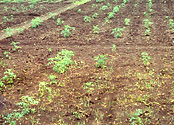 |
| Several books and articles are available on the subject. A very recent book,
Biohazard, written by K. Alibek and S. Hanelman (Random House, 1999) discussed Dr. Alibek’s experience with the former Soviet Union’s extensive BW program. Although Dr. Alibek referred to the former Soviet Union development of anti-crop pathogens as biological warfare agents, few details were provided. Alternatively, a more detailed and specific depiction of the potential of the crop threat was provided by Rogers et al. (1999). The authors recounted the history of anti-crop weapons as part of the United States’ program (disestablished in 1969) and the Iraqi anti-crop weapons effort (developed in the 1980s as a part of that country’s overall biological weapons program). Demonstrating the efforts that nations have undertaken to develop anti-crop weapons, the article is as interesting as it is alarming. |
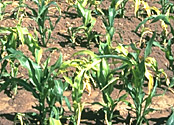
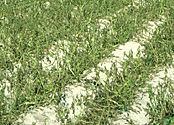
|
Over the past several years there has been an increase in new and emerging animal and plant diseases. Examples in the plant realm include bacterial canker of citrus (Xanthomonas campestris pv.
citri), watermelon fruit blotch (Acidovorax avenae subsp. citrulli), sorghum ergot (Claviceps africana), Karnal bunt of wheat (Tilletia indica), and scab of wheat (Fusarium .graminearum).The August APSnet feature on
"New and
Emerging Plant Viruses" (Damsteegt, 1999) listed sixteen new and emerging viral diseases including tomato infectious yellows, lettuce chlorosis, and high plains virus of corn |
Although the precise causes for the emergence of these diseases are not known, numerous explanations for these phenomena have been postulated by a variety of sources. Some explanations include natural causes such as climatological changes, man-made alterations in certain ecosystems, release of new germplasm, introduction of contaminated seeds, an increase in international air travel and trade, and so on. However remote, the possibility that some diseases could have occurred as a result of deliberate introduction cannot be dismissed.
|
Availability of information on anti-crop biological warfare (BW)
in the public domain
Although few books referencing BW matters mention anti-crop agents, recent articles and some internet web sites do refer to this subject. A special issue of Emerging Infectious Diseases published by the Centers For Disease Control and Prevention (Atlanta, GA), addressed a number of issues, including information-sharing (Kay et al., 1998), and bioterrorism and public health (Henderson, 1998; McDade and Franz, 1998). The current issue of Emerging Infectious Diseases (vol. 5, No. 4, 1999) is devoted to BW concerns. However, there is essentially no information concerning crop biosecurity. Some particularly useful examples of available information on anti-crop BW include; 1)the web publication,
The Battlefield of the Future which provides a description of several scenarios in which a foreign country or even unscrupulous businessmen may wish to employ plant diseases for economic gain (Chapter 10, Biological Weapons for Waging Economic War); 2) a report by the
Federation of American Scientists that was prepared by The Subgroup on Investigation of Alleged Use or Release of Biological or Toxin Weapons. This report covers a number of areas including ideas for strengthening current treaties and protocols. Appendix III discusses plant diseases and considerations for investigating a suspected occurrence of anti-crop warfare; 3) a NATO Advanced Research Workshop entitled "BTWC Security Implications of Human, Animal and Plant Epidemiology" which was held in the Cantacuzino Institute in Bucharest, Romania in June 1999. Major topics discussed at this workshop included the need for epidemiology and disease reporting and methods of outbreak investigation and analysis. This and other related reports can be found at the University of Bradford, Department of Peace Studies site; and 4) A microbiology course, formerly taught by Professor R. E. Hurlbert, included a chapter entitled "Biological Weapons; Malignant Biology". While a comprehensive overview of the subject matter is presented, little is included about crops. A list of over 70 potential biological agents includes eight plant pathogens (four bacteria, three fungi, and one virus). This non-validated but provocative site is provided for information only.
While not generally addressing plant diseases in the context of BW, the world wide web provides numerous resources of accurate and not-so-accurate information concerning general biological warfare and terrorism. As such, one should very carefully validate the sources and factual content of all data acquired through these resources. One resource is ZKEA. ZKEA offers online information about emerging diseases and has a large section on biological warfare issues that provides good background information, as well as many links.
Recognizing deliberate releases of plant pathogens
If we are to reduce the potential of deliberate introduction of crop pathogens, we must be able to fingerprint pathogens and discriminate between naturally occurring disease events and those which may be deliberately introduced for harmful purposes. The effective tracking of new and emerging diseases in the U.S. and throughout the world is critically needed to help make these determinations. An example whereby molecular fingerprinting has been used successfully to determine the geographic origin of different strains of a plant pathogen is the tracking of
Xanthomonas oryzae pv. oryzae, a destructive pathogen of rice (J. Leach, "Assuring food security: Detecting and controlling modified pathogens,"
see abstract). Unfortunately, because the international infrastructure concerning plant pathology is not well developed, the identification of a deliberate release of a pathogen is difficult to ascertain. A major cause of this deficiency is the absence of a rapid reporting system. |
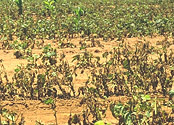
Click on the image for an
enlargement and more information. | This issue is discussed by R. L. Forster (see abstract) in his symposium presentation on "Ground Surveillance." To address this problem in rapidly and accurately reporting diseases, APS has discussed the possibility of supporting development of a global electronic reporting system to track new and emerging pathogens. There are some
excellent resources for reporting plant diseases and emerging plant diseases on the World Wide Web. However, these are not designed to address or help identify anti-crop activity and quality control is an issue. |
A list of plant pathogens that have been generally considered as potential anti-crop weapons can be compiled from several sources. One key source is the Australia Group. This informal group, comprising more than thirty nations including the U.S., was established in the 1980s to try to control the export of dual-use items and technology for chemical weapons by applying export licensing measures. In the 1990s controls for human, animal and plant pathogens and dual-use biological equipment were added. More than a dozen plant pathogens included for export control by the Australia Group are listed because of their harmful potential if transferred to nations with biological weapons programs or terrorists. An additional list of pathogens was provided by Weller et al. (1999) who discussed agents in the context of biological weapons and the problems that are posed for universities who wish to conduct research with organisms generally considered to be potential animal or plant weapons (Weller et al., 1999). Collectively, several plant pathogens believed to be suitable for weaponization are presented in Table 1. We assess that most of these pathogens have numerous deficiencies as bioterrorist or BW agents and, as such, may be inappropriate or too difficult to be used.
Table 1
Disease Agent |
Reference |
|
Virus | |
| Banana bunchy top virus | AG1 |
| Sugar cane Fiji disease agent | Weller et al. |
|
Fungi | |
|
Cochliobolus miyabeanus (Helminthosporium oryzae) | AG, Weller et al. |
|
Colletotrichum coffeanum var.
virulans (C. Kanawae) | AG, Weller et al. |
|
Deuterophoma tracheiphila (Phoma tracheiphila) | AG |
|
Dothistroma pini (Scirrhia pini) | Weller et al. |
|
Magnaporthe grisea/Pyricularia oryzae | Rogers et al., Weller et al. |
|
Microcyclus ulei (Dothidella ulei) | AG |
|
Monilia rorei (Moniliophthora rorei) | AG |
|
Phytophthora infestans | Rogers et al., Weller et al. |
|
Puccinia erianthi | Weller et al. |
|
Puccinia graminis (Puccinia graminis f. sp.
tritici) | AG, Rogers et al., Weller et al. |
|
Puccinia striiformis (Puccinia glumarum) | AG, Weller et al. |
|
Sclerotinia sclerotiorum | Weller et al. |
|
Tilletia indica | Weller et al. |
|
Ustilago maydis | Weller et al. |
|
Bacteria | |
|
Liberobacter spp. (Huanglonbin or citrus greening disease) | Weller et al., |
|
Erwinia amylovora | Weller et al. |
|
Ralstonia solanacearum | Weller et al. |
|
Xanthomonas albilineans | AG, Weller et al. |
|
Xanthomonas campestris pv.
citri | AG, Weller et al. |
|
Xanthomonas oryzae pv.
oryzae (X. campestris pv.
oryzae) | AG, Weller et al. |
|
Xylella fastidiosa | AG |
Genetically-modified micro-organisms. | AG |
1AG, Australia Group list of plant pathogens.
|
Click on the image for an
enlargement and more information.
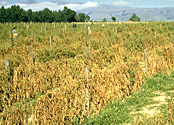
Click on the image for an
enlargement and more information. |
In his symposium presentation on epidemiology and risk prediction, Dr. L. V. Madden unveiled a probabilistic model for assessing the risk of crop bioterrorism (Dr. L. V. Madden, "Epidemiology and risk prediction,"
see abstract). The model includes the probability of introduction, initial establishment, disease spread, and control. If asked to list the top 10 candidate plant pathogens with high risk potential for deliberate introduction, most plant pathologists would probably list those pathogens with which they are most familiar and have historically caused severe crop losses in the past. Because a deliberate introduction may involve non-traditional agents or modified agents and might not follow historical trends, such a decision based on personal experience and history may very well be misleading. A better approach is to develop criteria and a numerical rating system or "Effective Pathogen Index" (EPI) to assess risk and probability of harm (N. W. Schaad, "What is an effective pathogen?"
(see abstract). A criteria and a numerical score such as the following could be developed:
Possible Bioterrorist Pathogen Rating Criteria and Points
| ! | Produces toxin | 15 |
| ! | Easy to obtain, handle, and deliver | 10 |
| ! | Easy to grow in large amounts | 10 |
| ! | Highly infectious under many conditions | 10 |
| ! | Results in the establishment of a quarantine | 10 |
| ! | No chemical control or host resistance available | 10 |
| ! | No method for rapid or reliable detection | 10 |
| ! | Infects systemically by natural means | 10 |
| ! | Spreads quickly by natural means | 5 |
| ! | Causes severe crop losses | 5 |
| ! | Survives long periods and is persistent | 5 |
A perfect organism would have a EPI of 10 (for example, add the total points and divide by 10). Similar criteria for a BW agent as part of a state supported BW program could be developed. These criteria could include many of the above plus points for ease of genetic manipulation.
To prepare our agricultural system to withstand a deliberate release of a plant pathogen, a serious evaluation of the appropriate threat agents must be performed. As stated by Dr. R. Hickson ("Subtle forms of strategic indirect warfare: infecting "soft" biological targets; some psychological, economic, and cultural consequences,"
see abstract) the psychological, economic, and cultural consequences of crop bioterrorism, especially attacks on such soft targets as crop seeds, could have a disproportionally adverse effect on our agriculture and society.
Conclusion
We urge all relevant agencies, to recognize the need to confront this threat and financially support appropriate research for fingerprinting high priority pathogens, detecting deliberate releases, developing rapid genetic-based diagnostic assays, epidemiology and risk prediction, and other scientific and technical approaches to reduce this risk. It is hoped that this article will stimulate further discussion of this topic.
Topics on crop biosecurity that need to be explored include the following:
- Awareness of the problem
- Involvement among plant pathologists
- Collaboration among government agencies, the commercial sector, international organizations, and universities
- Funding for all aspects of plant pathology research of significance to crop biosecurity, especially on molecular characterization and detection and identification of plant pathogens, and air and ground surveillance instrumentation
Additionally, training in these areas is much needed for those with responsibilities and interest in all sectors of crop agriculture including pathology extension specialists, students, crop consultants, federal and state regulators, and farm advisors at various levels.
Discussion topics
The APS has sponsored a web site for further discussion of the issues raised herein. Click the link titled in the top left margin titled "Discussion Area." Interested readers are urged to examine the comments posted by others and to post their own thoughts and ideas for the plant pathology community.
Literature cited
1. Alibek, K. and S. Hanelman. 1999. Biohazard: The Chilling True Story of the Largest Covert Biological Weapons Program in the World-Told from the Inside by the Man Who Ran It. Random House. (ISBN: 0375502319) 336 pp.
2. Damsteegt, V. D. 1999. New and emerging plant viruses. APSnet, August 1 to 31.
3. Henderson, D. A. 1998. Bioterrorism as a public health threat. Emerging Infectious Diseases (Special Issue) 4:488-492.
4. Kay, B. A., R. J. Timperi, S. S. Morse, D. Forslund, J. J. McGowan and T. O'Brien. 1998. Innovative information-sharing strategies. Emerging Infectious Diseases (Special Issue) 4:465-466.
5. McDade, J. E. and D. Franz. 1998. Bioterrorism as a public health threat. Emerging Infectious Diseases (Special Issue) 4:493-494.
6. Rogers, P., S. Whitby, and M. Dando. 1999. Biological warfare against crops. Sci. Am. 280:70-75.
7. Weller, R. E., C. W. Lyu, C. Wolters, and R. M. Atlas. 1999. Universities and the biological and toxin weapons convention. ASM News 65:403-409.
8. Whitby, S. and P. Rogers. 1997. Anticrop biological warfare-implications of the Iraqi and U.S. programs. Defense Analysis 13:303-318.
